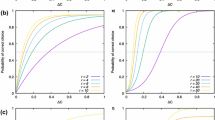Summary
Behavioural tests were carried out with 9 hymenopteran insect species, which ranked certain sets of coloured stimuli according to their subjective similarity to a previously memorized stimulus. Kendall's τ coefficient is employed for the analysis of correlation between these similarity rankings and the colour distance rankings predicted by various models of neural colour computation. The models are based on the measured spectral sensitivities of photoreceptor colour types and use a variety of simple colour coding systems to derive hypothetical colour distances. The correlation between the predictions of the models and the behavioural results serves as a measure for the likelihood of existence of a colour coding system. In all species, the similarity rankings can be best explained by assuming that colour is coded on a perceptual level by two colour opponent mechanisms. Brightness differences are ignored, indicating that an intensity-coding sub-system is not used in colour discrimination by the insects investigated. The weighting factors of the colour opponent mechanisms differ between species in detail, but not in the principles involved. It is thus possible to employ a standard measure of perceptual colour distance (colour hexagon distance) to predict the capacities of colour discrimination adequately in all the tested insects.
Similar content being viewed by others
References
Abney W de W (1913) Researches in colour vision. Longmans Green, London
Backhaus W (1991) Colour opponent coding in the visual system of the honeybee. Vision Res 31:1381–1397
Backhaus W, Menzel R (1987) Color distance derived from a receptor model of colour vision in the honey bee. Biol Cybern 55:321–331
Backhaus W, Menzel R, Kreißl S (1987) Multidimensional scaling of color similarity in bees. Biol Cybern 56:293–304
Beier W, Menzel R (1972) Untersuchungen über den Farbensinn der deutschen Wespe (Paravespula germanica F., Hymenoptera, Vespidae): Verhaltensphysiologischer Nachweis des Farbensehens. Zool Jb Physiol 76:441–454
Chittka L (1992) The colour hexagon: a chromaticity diagram based on photoreceptor excitations as a generalized representation of colour opponency. J Comp Physiol 170:533–543
Daniels HE, Kendall MG (1947) The significance of rank correlation where parental correlation exists. Biometrika 34:197–208
Daumer K (1956) Reizmetrische Untersuchungen des Farbensehens der Bienen. Z Vergl Physiol 38:413–478
Helversen O von (1972) Zur spektralen Unterschiedlichkeitsempfindlichkeit der Honigbiene. J Comp Physiol 80:439–472
Hertel H (1980) Chromatic properties of identified interneurones in the optic lobes of the bee. J Comp Physiol 80:439–472
Hertel H, Maronde U (1987) Processing of visual information in the honeybee brain. In: Menzel R, Mercer A (eds) The neurobiology and behavior of honeybees. Springer, Berlin Heidelberg New York London Paris Tokyo, pp 141–157
Kendall MG (1938) A new measurement of rank correlation. Biometrika 30:81–93
Kendall MG (1948) Rank correlation methods. (4. edition, 2. impression, 1975). Griffin, London
Kien J, Menzel R (1977) Chromatic properties of interneurones in the optic lobes of the bee. II. Narrow band and colour opponent neurons. J Comp Physiol 113:35–53
Laughlin SB (1981) Neural principles in the peripheral visual system of invertebrates. In: Autrum HJ (ed) Invertebrate visual centers and behavior (Handbook of sensory physiology, vol VII/6B) Springer, Berlin Heidelberg New York, pp 133–280
Lipetz LE (1971) The relation of physiological and psychological aspects of sensory intensity. In: Loewenstein WR (ed) Principles of receptor physiology (Handbook of sensory physiology, vol I.). Springer, Berlin Heidelberg New York pp, 191–225
Menzel R (1985) Learning in honeybees in an ecological and behavioral context. In: Hölldobler B, Lindauer M (eds) Experimental behavioral ecology. G Fischer, Stuttgart, pp 55–74
Menzel R, Greggers U (1983) Automated behavioral experiments with individually marked bees. Behav Res Meth Instrument 15:569–573
Menzel R, Lieke E (1983) Antagonistic colour effects in spatial vision of honeybees. J Comp Physiol 151:441–448
Menzel R, Ventura DF, Hertel H, de Souza M, Greggers U (1986) Spectral sensitivity of photoreceptors in insect compound eyes: comparison of species and methods. J Comp Physiol A 158:165–177
Menzel R, Backhaus W, Chittka L, Hoffmann M (1988) Honeybee drones are trichromats. In: Elsner N, Barth FG (eds) Sense organs. Thieme, Stuttgart, p 217
Menzel R, Steinmann E, de Souza JM, Backhaus W (1988) Spectral sensitivity of photoreceptors and colour vision in the solitary bee, Osmia rufa. J Exp Biol 136:35–52
Menzel R, Ventura DF, Werner A, Joaquim LCM, Backhaus W (1989) Spectral sensitivity of single photoreceptors and colour vision in the stingless bee, Melipona qwdrifasciata. J Comp Physiol A 166:151–164
Naka KI, Rushton WAH (1966) S-potentials from color units in the retina of the fish (Cyprinidae). J Physiol 185:536–555
Peitsch D, Backhaus W, Menzel R (1989) Color vision systems in hymenopterans; a comparative study. In: Erber J, Menzel R, Pflüger HJ, Todt D (eds) Neural mechanisms of behavior. Thieme, Stuttgart New York, p 163
Peitsch D, Fietz A, Hertel H, de Souza J, Ventura DF, Menzel R (1992) The spectral input systems of hymenopteran insects and their receptor-based colour vision. J Comp Physiol A 170:23–40
Riehle A (1981) Color opponent neurons of the honeybee in a heterochromatic flicker test. J Comp Physiol 142:81–88
Author information
Authors and Affiliations
Rights and permissions
About this article
Cite this article
Chittka, L., Beier, W., Hertel, H. et al. Opponent colour coding is a universal strategy to evaluate the photoreceptor inputs in Hymenoptera. J Comp Physiol A 170, 545–563 (1992). https://doi.org/10.1007/BF00199332
Accepted:
Issue Date:
DOI: https://doi.org/10.1007/BF00199332




